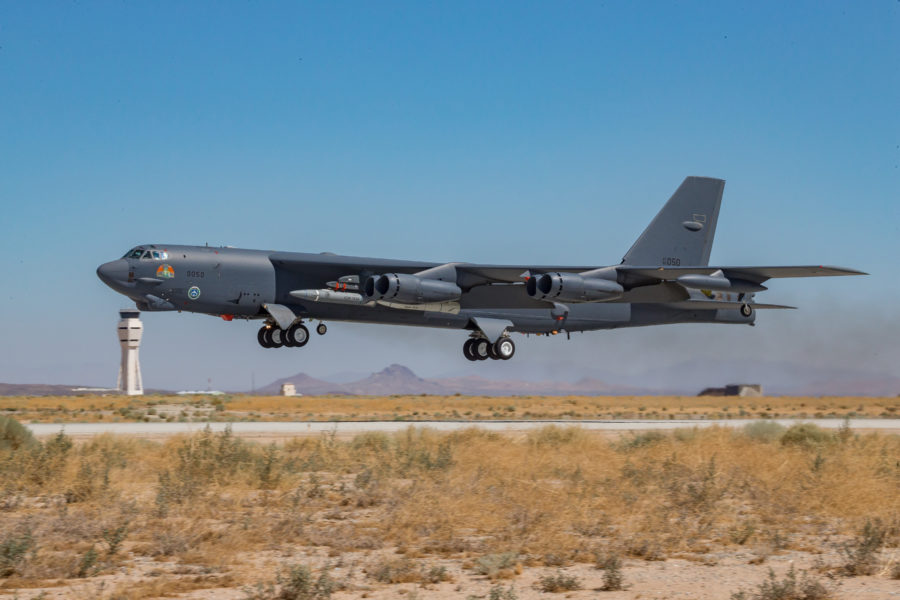The proliferation of long-range strike options under development across all the U.S. armed forces should prompt a comprehensive review by civilian leaders, a new report by two influential think tanks concludes.
The civilian review should ensure theater commanders have the most cost-effective mix of options available should they be needed in a peer fight, while eliminating duplicative capabilities, said Mark Gunzinger, director of future concepts and capability assessments at AFA’s Mitchell Institute for Aerospace Studies; Lukas Autenried, a Mitchell analyst; and Bryan Clark, director of the Center for Defense Concepts and Technology at the Hudson Institute.
Titled “Understanding the Long-Range Strike Debate,” the report argues that while a mix of options is always advantageous, the true cost of those options must be well understood and the opportunity cost of pursuing more options could deprive commanders of better options over time. It was unveiled at a virtual Aerospace Nation event April 22.
“Our report coming out today is not about the parochial interests of any particular service,” Gunzinger said. The problem is not a lack of new weapons options, but rather too many. “All of the services are pursuing new capabilities to meet [today’s] shortfall. We recommend [the Defense Department] take a balanced approach to filling its long-range strike shortfall, which, quite frankly, was created by its failure to acquire next-generation strike weapons and platforms over the past few decades.”
Clark said having a range of land-based, sea-based, and air-launched strike options can be valuable, citing recent comments by both Vice Chairman of the Joint Chiefs of Staff Gen. John E. Hyten and the newly confirmed commander of Indo-Pacific Command, Adm. John C. Aquilino.
“Having ground-based fires does support some advantages,” Clark said. “They’re more persistent. They don’t necessarily require as much overhead … so they can provide this ability to deter or impact the adversaries’ thinking in advance of conflict—in a way that air-delivered fires or surface-delivered fires [from ships] don’t necessarily do.” However, he added, those advantages evaporate in a contested environment.
Naval strike capabilities are significantly more expensive, carrying the costs of shipbuilding and a large crew, while potentially getting closer to an adversary, he said. But in a conflict with China, with its own large naval force and long-range anti-access/area denial weaponry, Clark said, U.S. ships may be preoccupied defending themselves and unable to focus on long-range missions.
Another aspect of what Clark calls “overhead” is the command and control needed to manage long-range strike. “One of the overhead items that you have to think about for strike is, how do you get the targeting information to the shooter? And how do you get the commander in there to be able to make a decision on whether to shoot or not, and what to target?” Clark said.
The Air Force, Navy, and Space Force are already there, while the Army would have to develop something new. He questioned the Army’s plan to develop its own tactical space network as “pretty redundant to what has already been pursued by the Space Development Agency, the Space Force, and DARPA, and also in the commercial world.”
The cost of individual weapons is also a factor. While an aircraft costs more to build and operate than a land-based launcher, the cost comparison of the munitions is the opposite. Like a cheap ink-jet printer, where the up-front cost is less but the cartridges are expensive, it’s only cost-effective if used sparingly. “Costs stack up really fast,” said Autenried. “That doesn’t mean there aren’t targets that are so high value and so important that it’s worth actually spending that money to go strike them, but those are going to be few and far between.”
This is why a cost-effectiveness analysis is so important, Gunzinger said. “When most people talk about cost, they tend to think about the unit cost to buy a weapon, or a jet, or ship, or whatever,” he said. “But what matters more is the cost to complete a specific task, like destroying a target or achieving a mission kill that renders a target incapable of continuing operations. That’s what a cost effectiveness analysis would get.”
Such an analysis must take into account “the cost of weapons expended to achieve those effects, the cost of the launch platform, the logistics needed to sustain them, and then the costs to defend them and their operating locations against enemy attacks,” Gunzinger said.
Clark agreed. “If we think we’re going to be faced with a situation where a few weapons might be needed to be launched, well, an Army missile battery may be the cheapest way to do that,” he said. “It doesn’t require a ton of defenses, doesn’t have the infrastructure or the fuel farms or anything else to protect, so … it gives you some escalation options at a lower level instead of having to flow bombers in to attack Mainland China. …. But once things become contested, they’re very hard to defend.” Airpower would then be more cost-effective. “Bombers could be coming from a more distant base that doesn’t require as much defense.”
